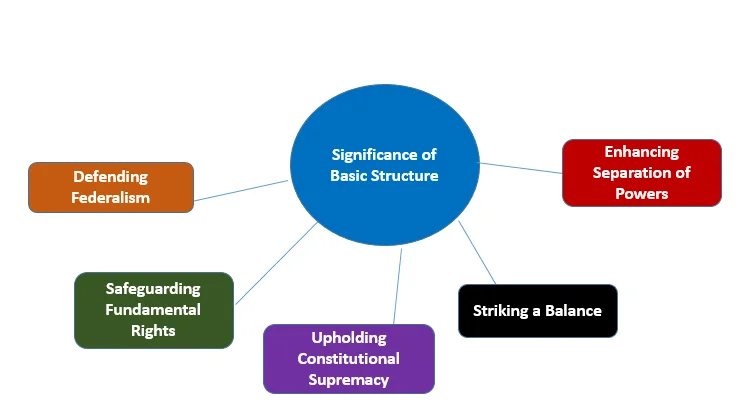The Basic Structure doctrine has profoundly influenced India’s legal and political framework by protecting key constitutional principles from being altered by Parliament. It ensures that essential features of the Constitution, such as separation of powers and fundamental rights, remain intact. This doctrine highlights the balance between legislative amendments and judicial oversight. Introduced in the 1973 Kesavananda Bharati case, it remains vital for upholding constitutional integrity.
Understanding the Basic Structure Doctrine: Evolution, Significance and Key Cases
Significance of Basic Structure
- Implications and Application of the Basic Structure Doctrine: The Basic Structure doctrine has had far-reaching implications for the Indian legal and political system.
- It has been applied in various cases, including those related to constitutional amendments, to protect the core principles and values of the Indian Constitution.
- The significance of Basic Structure is as follows:
- Enhancing Separation of Powers: By emphasizing a true separation of powers, the Basic Structure doctrine ensures the independence of the judiciary from the other branches of government, reinforcing the democratic framework.
- Striking a Balance: Granville Austin contends that the Basic Structure Doctrine achieves a balance between the responsibilities of Parliament and the Supreme Court, thereby safeguarding the intricate framework of the Indian Constitution.
- Preserving Constitutional Ideals: The Basic Structure doctrine aims to safeguard constitutional principles and the fundamental ideals envisioned by the framers of the Constitution.
- Safeguarding Fundamental Rights: One of the pivotal roles of the Basic Structure doctrine is to shield the fundamental rights of citizens, offering protection against legislative arbitrariness and authoritarianism.
- Dynamic Constitution: Recognizing the dynamic nature of the Constitution, the Basic Structure doctrine allows for progress and adaptability over time, transforming the Constitution into a living document.
- Defending Federalism: The doctrine has been used to protect the federal structure of the Indian Constitution.
- It ensures that the division of powers between the central and state governments remains intact.

Enroll now for UPSC Online Course
Key Issues surrounding the Basic Structure Doctrine
No constitutional basis: The Constitution as a whole is a basic law, and the Basic Structure provision is an attempt to locate something even more basic than that.
- This line of thought was not there in the constituent assembly.
- The constituent assembly had never notified that some features were more important than others.
- Scope of the Basic Structure: One of the primary debates centers around what constitutes the “Basic Structure” of the Indian Constitution.
-
- While certain principles like democracy, secularism, and the rule of law are widely accepted as part of the Basic Structure, there is ongoing discussion about whether specific policies or provisions, such as reservation policies, fall within this framework.
- Constituent Power of Parliament vs. Judicial Review: There is an ongoing debate about the balance of power between the judiciary and the legislature.
- Critics of the doctrine have called it undemocratic since unelected judges can strike down a constitutional amendment.
- At the same time, its proponents have hailed the concept as a safety valve against majoritarianism and authoritarianism.
- Role of the Judiciary: Some critics question the extent to which the judiciary should have the authority to decide what constitutes the Basic Structure.
- There are debates about whether the judiciary is overreaching and acting as a “super-legislature”, the Third chamber of the Parliament”.
- Decision to include or exclude features based on subjective assessment: The power to decide the inclusion of subjects in the Basic Structure lies with the apex court bench and the judges on it.
- Hence any subject’s inclusion or non-inclusion is based on a subjective assessment of the individual judge, which can vary from person to person and even time.
These issues reflect the complex and evolving nature of constitutional law and governance in India. Public discourse, judicial decisions, and academic scholars continue to shape the understanding and application of the Basic Structure doctrine.
Important Cases related to the Basic Structure of the Indian Constitution
| Case | Features |
| Golaknath v. State of Punjab, 1967 |
|
| Kesavananda Bharati v. State of Kerala, 1973 |
|
| Indira Gandhi v. Raj Narain,1975 |
|
| Minerva Mills Ltd. v. Union of India, 1980 |
|
| Waman Rao v. Union of India, 1981 |
|
| S.R. Bommai v. Union of India,1994 |
|
| L. Chandra Kumar v. Union of India, 1997 |
|
| I.R. Coelho v. State of Tamil Nadu,2007 |
|
| Madras Bar Association Case(2014) |
|
| Justice K.S. Puttaswamy (Retd.) v. Union of India (Aadhaar Case) 2017 |
|
| Navtej Singh Johar v. Union of India, 2018 |
|
| Puttaswamy (Privacy), 2021 |
|
Enroll now for UPSC Online Course
| Must Read | |
| Current Affairs | Editorial Analysis |
| Upsc Notes | Upsc Blogs |
| NCERT Notes | Free Main Answer Writing |
Conclusion
The Basic Structure of the Indian Constitution, integral to constitutional jurisprudence, evolved with various judicial pronouncements to limit the Parliament’s power to amend the Constitution.
- Various constitutional thinkers have emphasized the crucial role of this doctrine in preserving the liberal democracy in India.
- This doctrine provides a mechanism for preserving the fundamental principles and values of the Constitution, ensuring its continuity and stability while allowing for necessary changes within its established framework.
Sign up for the PWOnlyIAS Online Course by Physics Wallah and start your journey to IAS success today!

 GS Foundation
GS Foundation Optional Course
Optional Course Combo Courses
Combo Courses Degree Program
Degree Program









